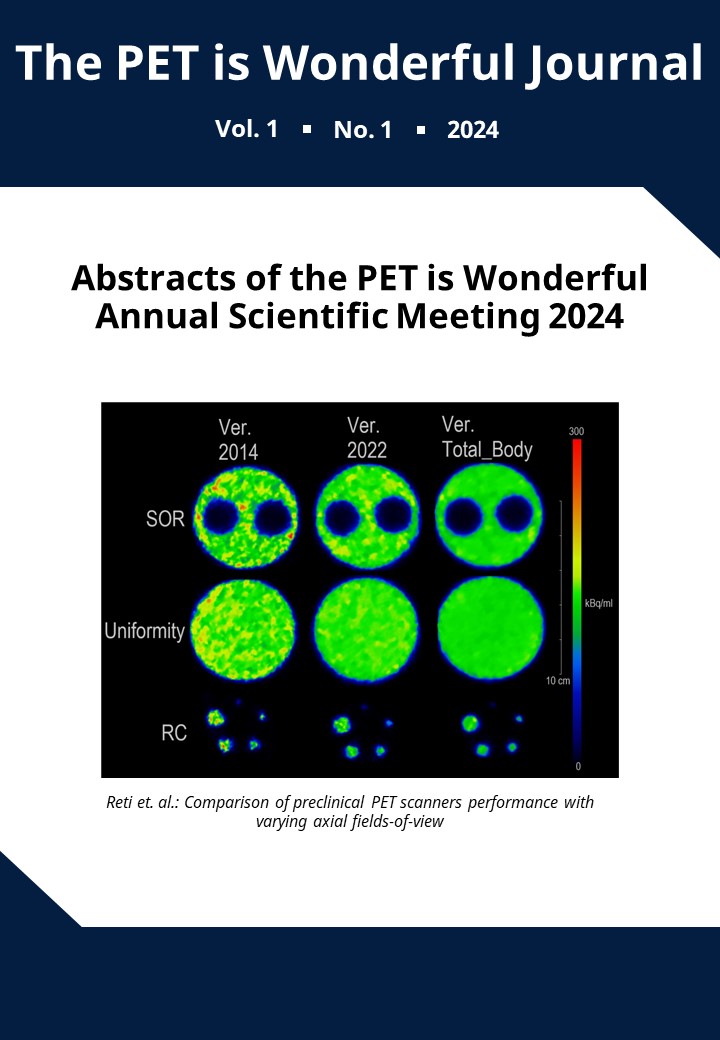Valvular and Myocardial Fibroblast Activation in Aortic Stenosis
DOI:
https://doi.org/10.2218/piwjournal.9967Abstract
Activated fibroblasts drive leaflet thickening and left ventricular decompensation in aortic stenosis. Gallium-68 Fibroblast Activation Protein Inhibitor (68Ga-FAPI) binds to these key effector cells, and provides a readout of fibroblast activation. We aimed to describe the role of activated fibroblasts in patients with aortic stenosis in vivo using 68Ga-FAPI.
In a prospective observational study, patients with aortic stenosis and control subjects underwent echocardiography, 68Ga-FAPI PET, CT, and MRI. Valvular and myocardial 68Ga-FAPI uptake was quantified using maximal standardised uptake values (SUVmax), and target-to-background ratio (TBRmax). Aortic stenosis severity was measured by peak velocity on echocardiography and the CT calcium score. Myocardial fibrosis was quantified by late gadolinium enhancement (LGE) on MRI.
86 patients with aortic valve disease (72±11 years, 68% male) plus 9 matched control subjects (72±9 years, 67%% male) participated. Increased 68Ga-FAPI uptake was observed in the aortic valves of patients with aortic stenosis compared with controls (p<0.001). 68Ga-FAPI TBRmax correlated with peak velocity (r=0.532, p<0.0010) and calcium score (r = 0.577, p<0.001). 54 patients (69%) had myocardial 68Ga-FAPI uptake, of whom 30 (38%) also had LGE corresponding to the region of 68Ga-FAPI uptake. Myocardial 68Ga-FAPI uptake correlated with increased indexed left ventricular mass (r=0.429, p<0.001) and indexed Extracellular Volume (r=0.404, p<0.001).
For the first time, we have described valvular and myocardial fibroblast activation in patients with aortic stenosis in vivo. Valvular fibroblast activation is increased in patients with aortic stenosis, correlating with increased disease severity. Myocardial fibroblast activation is seen in the majority of patients with aortic stenosis in areas with and without established fibrosis, and is associated with adverse left ventricular remodelling. 68Ga-FAPI PET can visualise the key effector cell driving aortic valve disease, and may have a role in monitoring disease modifying treatments, as well as identifying patients at high risk of myocardial decompensation.
Please click on the 'PDF' for the full abstract!
Downloads
Published
Issue
Section
License
Copyright (c) 2024 Neil Craig, Michael McDermott, Jolien Geers, Krithika Loganath, Menaka Mahendran, Laura Clark, Audrey White, Beth Whittington, Anna Barton, Craig Balmforth, Joel Lenell, Michelle Williams, Edwin van Beek, Damini Dey, Piotr Slomka, David Newby, Marc Dweck

This work is licensed under a Creative Commons Attribution 4.0 International License.





